Testing a material’s hardness is an important method for evaluating its resistance to deformation. This process involves measuring the indentation on a material’s surface and translating it into a hardness value. Hardness test is an essential part of quality control during manufacturing and is used to compare materials fitment for a range of applications, from cutting and grinding metals to rubbers designed to absorb shocks. This is where the Telebrineller Brinell Systems comes in handy!
The hardness test, however, is not without its challenges. As surface condition significantly influences hardness readings, precise and repeatable results are dependent on proper surface preparation, usually involving grinding and polishing. With older testing machines, it can also be challenging to measure the size of indentations, especially on non-flat surfaces. Advanced technologies, such as cameras and software, have improved the precision and ease of use of modern models.
This blog will explore hardness testing in depth, with a focus on our advanced Telebrineller Brinell Hardness Testing System. This system offers simplicity, precision, and versatility, suitable for a wide range of materials. It is our goal to provide insight into how the Telebrineller system improves test efficiency and accuracy by exploring how it works.
What is Hardness Testing?

Hardness testing, an essential part of material science, measures how well a material resists permanent distortion, penetration, indentation, and scratching. From an engineering perspective, this property correlates with wear resistance under different conditions such as friction, erosion, and exposure to elements such as steam, oil, and water. Tests assess how much pressure a material can withstand before altering its shape by applying a specific, known force to its surface.
Choosing materials for specific environments and uses requires an understanding of their hardness. For example, in environments where small particles may cause material wear, the hardness determines how well the material resists being deformed or indented. Brinell, Rockwell, Vickers, and Knoop test methods are suitable for different purposes and materials, providing diverse means of measuring hardness.
Brinell Hardness Testing
Since we will focus primarily on this method of hardness testing today, it’s necessary to gain a deeper understanding. Brinell hardness testing, widely used in industrial applications, determines metal hardness based on the size of indentions caused by specific indenters. Developed by Johan August Brinell in 1900, this method uses a tungsten carbide ball as an indenter. Brinell Hardness Number (BHN or HBW) is calculated by measuring the depth of the indentation, which is inversely related to the hardness of the material.
This test involves pressing a tungsten carbide ball into a test material using a predetermined force. Testing machines consist of levers, weights, hydraulic dashpots, and plungers that apply forces ranging from 1 kg to 3000 kg. Indenters typically come in four sizes: 1 mm, 2.5 mm, 5 mm, and 10 mm.
There are several standards governing Brinell hardness tests, including ASTM E10, ISO 6506, and JIS Z 2243. Through these standards, testing for hardness is consistently and reliably performed across an array of industries.
The Brinell test method measures the hardness of rough samples, applies high loads, and can be applied to a wide range of metals, providing reliable results. It does, however, have limitations, including potential measurement errors due to optical instruments, surface preparation requirements, and inapplicability for cylindrical surfaces or materials above 650 HBW 10/3000.
Testing hardness, particularly using the Brinell method, is a cornerstone of assessing materials’ durability and suitability. We focus on Brinell Hardness Testing in this blog because the Telebrineller Brinell Hardness Testing System uses this method, making the data it provides highly accurate.
Introducing the Telebrineller Brinell Hardness Testing System
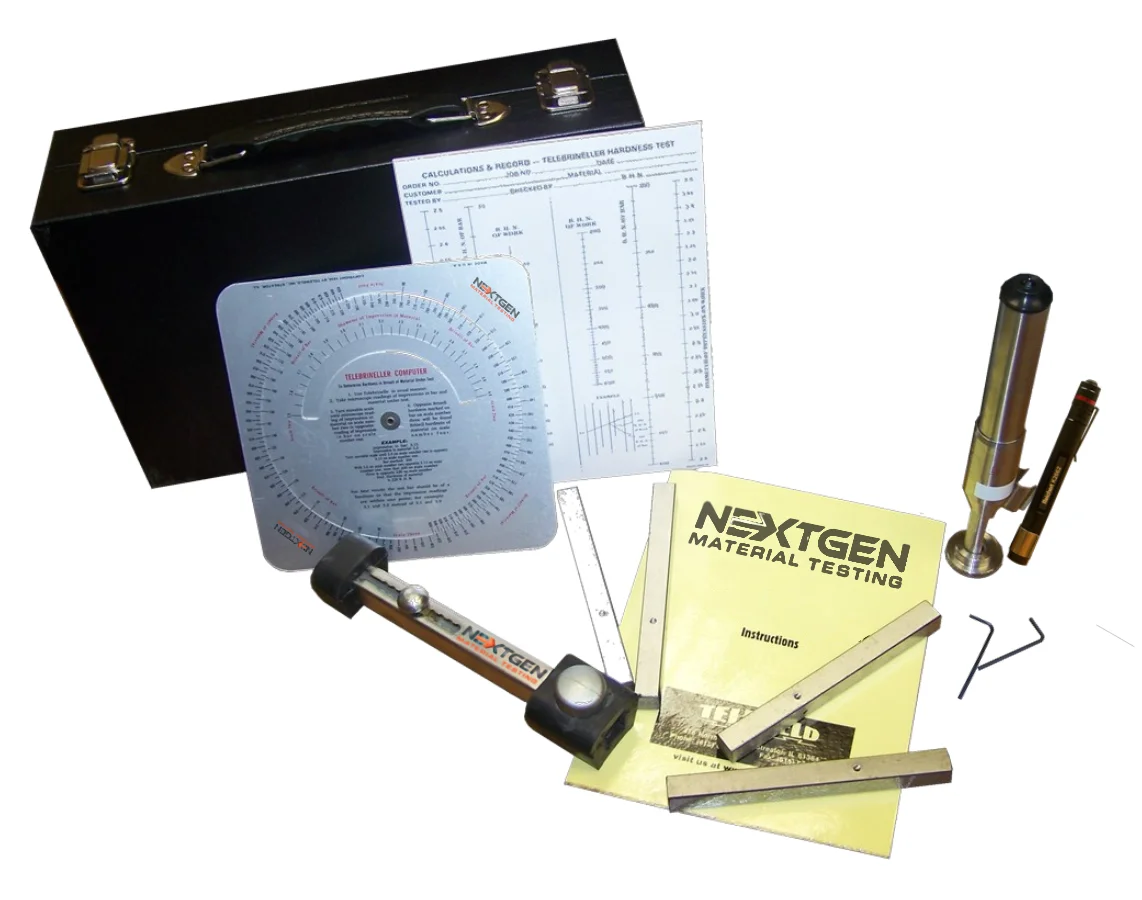
Our Telebrineller Brinell Hardness Testing System has been recognized as a superior quality assurance solution. This welding crew-specific system was designed based on over fifty years of field experience and metallurgical expertise. In addition to its portability, the complete system, encased in a durable case, weighs under ten pounds, making it easily transportable and ideal for measuring hardness in any environment.
Telebrineller’s operation is remarkably simple. An easy hammer blow is used to measure the impressions, followed by a basic calculation on the included computer. Brinell Hardness Number (BHN) can be determined quickly and accurately without specialized training.
A calibrated test bar ensures precision to within 0.05 millimeters of the labeled BHN, ensuring the accuracy of the system. By complying with the National Standards Institute’s rigorous requirements, this calibration is meticulously carried out. With its weather-proof design and robust components, our Telebrineller system guarantees accurate measurements in tough field conditions regardless of weather conditions.
A Telebrineller Brinell Hardness Testing System also meets ASTM E10 standards, ensuring compliance with other global standards. As a result of its ability to comply with established standards, the system is known for its reliability and suitability for many types of industrial uses.
Telebrineller System Operation Principle
Telebrineller Brinell Hardness Testing System is based on a straightforward principle. The first step is to select a test bar that closely matches the expected hardness of the specimen by Brinell Hardness Number (BHN). For consistent accuracy, the BHN of the test bar should be within + or – 15% of the BHN of the specimen, and the materials should be similar. Non-ferrous materials tested with carbon steel bars should be corrected for impact errors using designated correction factors. After selecting the test bar, it is inserted into the Telebrineller instrument, which is then precisely positioned on the specimen.
Standard Telebrineller Testing System Kit with Accessories
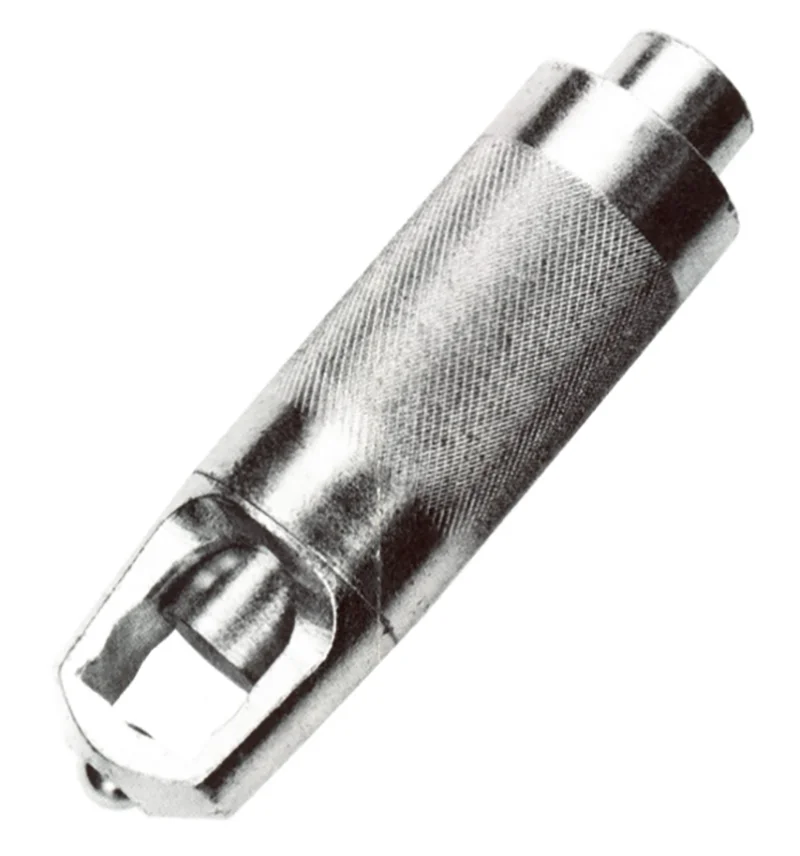
Telebrineller’s hardness testing instrument comes with a comprehensive standard kit that includes all the components you need to conduct an effective test. This kit includes a test bar, an anvil, and a molded rubber head. This helps to ensure stability and non-skid contact with the test bar. Also included in the unique construction is a steel impression ball embedded at the base of the rubber head, which is crucial for creating accurate impressions on both the test bar and specimen.
With a hammer weighing between two and five pounds, a sharp strike is applied to the anvil to operate the system. As a result of this design, the impact force, regardless of its magnitude, is evenly distributed between the test bar and the specimen. By uniformly transmitting force via the impression ball, precise impressions are created, which are used to determine the hardness levels of materials. Further, the system includes a spacing bar with a spring catch and button that enables the test bar to be adjusted for each test.
Accuracy of Telebrineller Brinell Hardness Testing System
Our product is highly acclaimed for its accuracy, which makes it the best choice for Brinell Hardness Testing. Telebrineller Brinell tester exemplifies precision in material testing, anchored by Telebrineller Test Bars. Precision-ground to a 9/16″ square finish, these bars are meticulously crafted from various carbon steel alloys to ensure a uniform hardness of plus or minus 2% of the Brinell Hardness Number (BHN) etched on each bar.
With the King-Scan, an advanced computerized calibration system, accurate measurements of impression diameters are made to determine BHN. By ASTM Standard E10 guidelines, BHN values are rounded to the nearest standard at a .05mm interval. The National Institute of Standards has set these standards. It is noteworthy that the Telebrineller system’s accuracy depends on the relative hardness between the test bar and the specimen. It can consistently achieve +/- 5% accuracy when the test bar’s BHN is within 15% of the specimen’s BHN.
Who Can Benefit from NextGen’s Telebrineller System?
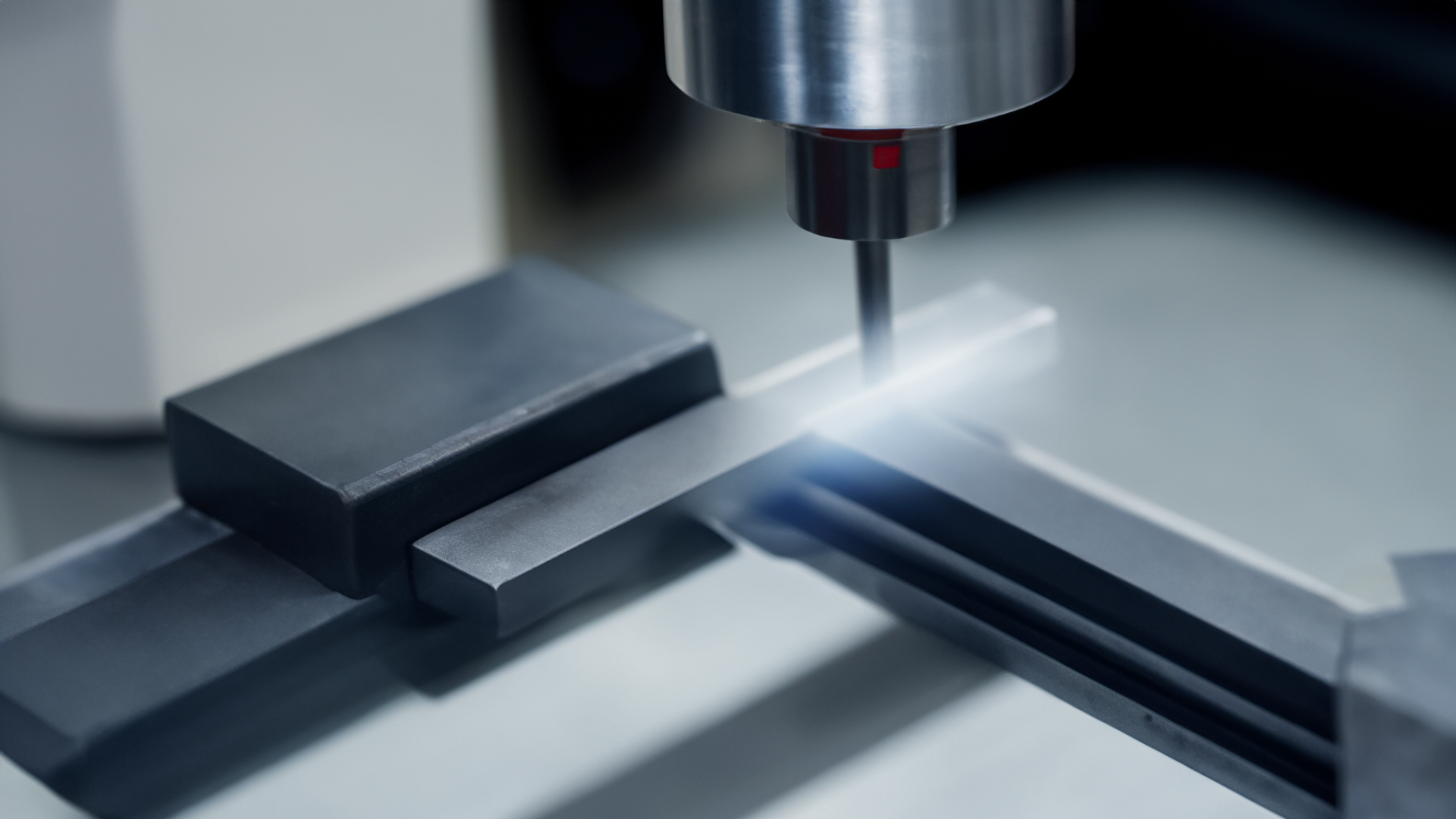
Having reviewed the general information about our tester, one question remains – who needs it, and who can benefit from it? Well, the Telebrineller Brinell Hardness Testing System can be used by individuals and companies across industries. The ease of operation and convenience of this machine make it particularly useful, for example, to welding crews. In contrast to traditional methods of hardness testing, which require a laboratory, Telebrineller provides on-site, immediate testing. Especially in field conditions, this portability and practicality significantly streamline project progress.
The Telebrineller System is also beneficial to materials testing laboratories, quality control departments, and research facilities. The device’s ability to precisely measure the hardness of metal samples, including unknown metals, enhances research, quality assessments, and safety verifications. As an essential tool for assessing the safety and compliance of materials and structures, the system can determine load-bearing capacities and structural integrity, such as the strength of train track sections.
Metal-related industries, such as construction, manufacturing, and engineering, can greatly benefit from the Telebrineller System too. The system’s components, including test bars certified by the National Standards Institute, ensure reliable and traceable hardness measurements.
Further, with a hammer large enough to create significant indentations on larger metal surfaces, the Telebrineller System is effective for testing large specimens. Its availability for next-day shipment further enhances its appeal to industries requiring quick and efficient hardness testing solutions.
Last but not least, the complete kit comes in a light metal carrying case that makes the system easy to transport and use. In a variety of situations, thickness, alloy, position, geometry, rust, or paint do not affect measurement accuracy.
LeebGen 3000 – Another Great Choice for Hardness Testing
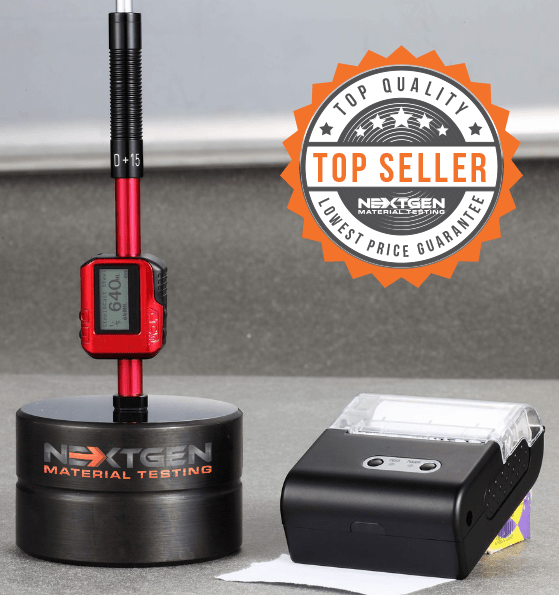 LeebGen 3000 Portable Rebound Tester is another outstanding product we offer along with the NextGen’s Telebrineller Brinell Hardness Testing System. By offering a non-destructive, precision-based approach to metal hardness measurement, this advanced hardness tester complements the versatility of the Telebrineller system. With its innovative design, it offers a formidable alternative to traditional stationary metal hardness testers like Vickers, Brinell, and Rockwell. Designed to meet the latest industry standards, the LeebGen 3000 is ideal for professionals seeking an accurate yet portable solution.
LeebGen 3000 Portable Rebound Tester is another outstanding product we offer along with the NextGen’s Telebrineller Brinell Hardness Testing System. By offering a non-destructive, precision-based approach to metal hardness measurement, this advanced hardness tester complements the versatility of the Telebrineller system. With its innovative design, it offers a formidable alternative to traditional stationary metal hardness testers like Vickers, Brinell, and Rockwell. Designed to meet the latest industry standards, the LeebGen 3000 is ideal for professionals seeking an accurate yet portable solution.
The LeebGen 3000 provides excellent image quality under various conditions thanks to its large, high-contrast LCD screen. A standout feature is its self-contained Universal D Impact device, which eliminates cumbersome cables, making it portable and easy to use. Due to its 360° automatic angle adjustment, the unit provides precision within +/-4HL in any impact direction.
By using the LeebGen 3000, you can manage and transfer data more efficiently. There is a USB port for easy data transfer to a PC, and professional software is provided for free. A combination of this feature and internal data storage that records dates and times of use makes it a highly efficient tool for comprehensive hardness testing.
The LeebGen 3000 is not only a stand-alone product but also enhances NextGen’s hardness testing capabilities. Together with the Telebrineller Brinell Hardness Testing System, it forms a comprehensive toolkit that caters to diverse measuring needs across multiple industries. Together, these two products demonstrate our commitment to innovative and reliable material testing solutions.
Additional Consumables for the Telebrineller Testing System
It is worth noting that our company can offer you more than just the standard kit with accessories for our Brinell Hardness Testing System. NextGen Brinell Hardness test blocks are a valuable addition to our product line, designed to complement Telebrineller.
Assuring compliance with industry regulations, NextGen’s Brinell test blocks are certified to relevant standards, including ASTM E-10 and ISO 6506. These blocks are carefully calibrated, with a proving ring and load cell traceable to the National Institute of Standards and Technology (NIST) for maintaining the tester’s accuracy. Hardness measurements are performed using a calibrated stage micrometer that is also NIST traceable, ensuring high precision and reliability.
Brinell test blocks are available in a wide range of load capacities, from 62.5kg to 3000kg, covering all hardness levels. Telebrineller’s system requires these blocks to be precise and trustworthy, providing a comprehensive solution for hardness testing.
Industries and Products That Require Brinell Hardness Testing
To determine if the Telebrineller system is right for you, it’s crucial to understand the various industries and applications that utilize it. From construction materials to aerospace components, instruments like our Telebrineller Brinell Hardness Testing System are not limited to a small list of products that require testing for production. Let’s explore the range of industries and the most common products that necessitate testing with our device.
Let’s consider the most common industries:
Construction Industry
Hardness testing ensures that construction materials such as steel beams, reinforcing bars, and structural plates can withstand heavy loads and environmental stress. Brinell hardness tests determine the capacity of steel to sustain weight, resist deformation, and handle varying climatic conditions in critical structures like skyscrapers and bridges. Buildings and infrastructure need to undergo this testing to ensure their safety, longevity, and structural integrity.
Automotive Industry
In the automotive industry, key components such as engine blocks, gears, and axles are heavily tested for hardness. Vehicle safety and performance are affected by these parts, which must withstand extreme stresses and wear. Brinell’s method makes these components durable and reliable. This contributes to the vehicle’s overall longevity and efficiency. Material failure can have serious safety implications in automotive manufacturing, where high standards are required to maintain high safety standards.
Aerospace Industry
The material used for aircraft structures, turbine blades, and fuselage frames undergoes thorough hardness testing. This method helps verify that these materials can withstand the unique challenges of flight, including dramatic pressure and temperature changes. Materials such as titanium alloys are tested for their hardness as part of aerospace applications where failure of the material is not an option.
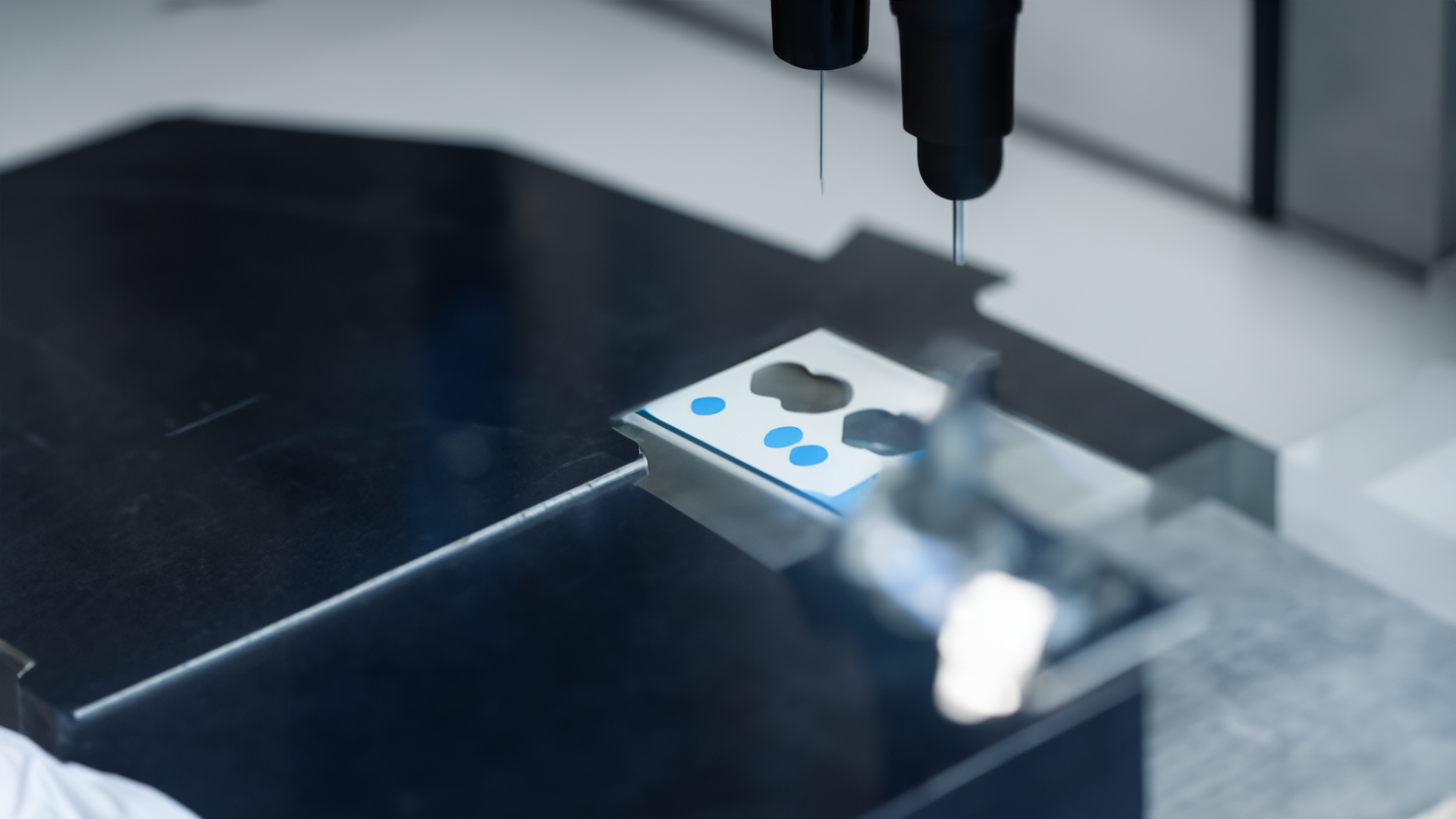
Heavy Machinery Manufacturing
During the manufacturing of heavy machinery, hardness testing is done to verify that materials used in construction and agricultural equipment can withstand demanding conditions. Testing for hardness is vital to confirm the efficiency and durability of hydraulic arms and digging tools. Brinell tests provide accurate measurements of the material’s ability to withstand stress, wear, and tear, ensuring machinery’s long-term performance and reliability.
Tool and Die Manufacturing
Shapes of tools and dies must be maintained under stress and avoid rapid wear. A Brinell hardness test measures the hardness of drill bits, cutters, and molds, which directly impacts their performance and lifespan. The quality and functionality of the final product depend on precision durability in the tool and die industry.
This list shows how hardness testing, especially Brinell testing, and tools like our Telebrineller testing system play an essential role across a broad range of applications. From industrial drills to home furnishings, they enable the production of top-notch equipment.
Summarizing the NextGen Telebrineller Brinell Hardness Testing System
This NextGen Telebrinell Brinell Hardness Testing System is a result of extensive metallurgical research and expertise and is the best choice for professionals seeking accurate hardness measurements. This design combines precision, versatility, and user-friendliness, making it suitable for an array of materials and industries, from heavy machinery to delicate aerospace components.
Its portability makes it an ideal tool for both field and laboratory use. Construction and manufacturing industries, which require on-site testing, will particularly benefit from this feature. Due to its robust design, the system maintains accuracy and reliability under different environmental conditions.
Telebrineller’s system is based on accuracy, which is ensured by certified test bars. Using National Standards as a guide, these bars undergo rigorous calibration, resulting in high-quality measurements. By paying attention to calibration details, along with its compatibility with Brinell Hardness Test Blocks, the system proves reliable for a variety of hardness testing tasks.
Besides its technical prowess, the Telebrineller system is user-friendly, and designed with non-specialist users in mind. Users of all skill levels can benefit from it since it simplifies the hardness testing process without compromising on precision. Whether used for education, quality control, or research, the Telebrineller system represents NextGen’s dedication to excellence in material testing.
Commitment to Excellence by NextGen Material Testing
Our philosophy at NextGen Material Testing is to deliver the highest quality products and customer service. To offer clients the best technology-based equipment available, NextGen stands out for its customized approach, emphasizing quality and service above all else. User-friendly product designs reflect the company’s commitment to innovation, which ensures optimal quality control and efficiency for each customer.
Please do not hesitate to contact us directly or request a quote online if the NextGen Telebrineller Brinell Hardness Testing System, its additional consumables, or any other product from NextGen Material Testing catches your interest. We are happy to assist you with any inquiries and provide individualized solutions to meet your specific needs.